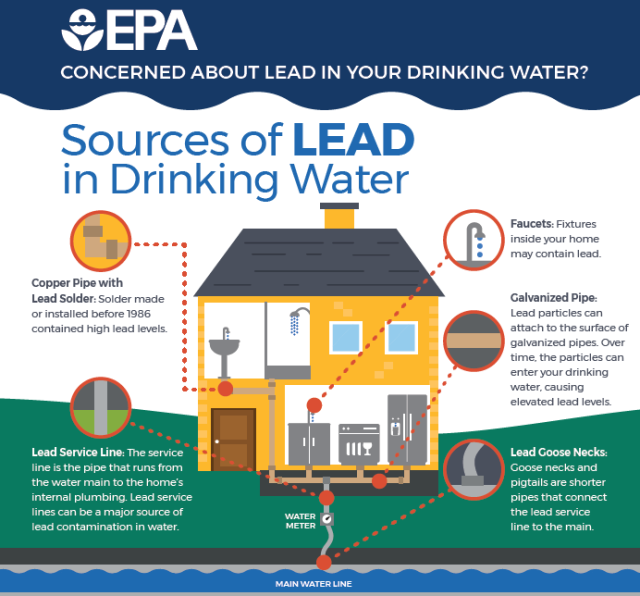Getting Started with Lead Service Line Identification and Replacement
There is no level of lead that is considered safe. Lead can enter drinking water from a variety of plumbing materials. The most common sources of lead in drinking water are lead pipes and brass or bronze faucets and fixtures. A service line is the pipe that connects the water main to the plumbing in a home or building. When any part of that pipe is made of lead, it is called a lead service line (LSL).
Lead service lines were installed primarily during the late 1800s through the 1940s. Knowing the locations of lead service lines is challenging for many communities due to poor recordkeeping and long histories of repairs.
Given the public health risks, there is a need to identify lead service lines on both public and private property so that they can be removed.
On this page:
Lead and Copper Rules
In 1991, EPA established the Lead and Copper Rule (LCR) to protect public health and reduce exposure to lead and copper in drinking water. Since then, the LCR has undergone various revisions. In order to better protect children and communities from the risks of lead exposure, get the lead out of our nation’s drinking water, and empower communities through information, EPA published the 2021 Lead and Copper Rule Revisions. One requirement of this rule is for PWSs to prepare and maintain an inventory of service line materials by October 16, 2024 to submit to their state primacy agency.
On December 16, 2021 EPA announced the development of a new regulation, the Lead and Copper Rule Improvements to strengthen the LCR.
EPA Activities Related to LSLs
Lead Service Line Identification and Replacement Research
EPA, its federal partners at the Departments of Health and Human Services (HHS) and Housing and Urban Development (HUD), and private organizations have conducted and used lead research and applied science for a variety of science activities and technical products.
Learn more about EPA’s Office of Research and Development’s work on lead and approaches to identify lead service lines.
Lead Service Line Replacement Accelerators
Through the Lead Service Line Replacement (LSLR) Accelerators, EPA is providing hands-on support to guide 40 communities across Connecticut, New Jersey, Pennsylvania, and Wisconsin through the process of lead service line removals, from start to finish. This includes support in conducting inventories to identify lead pipes, developing lead service line replacement plans, increasing community outreach and education efforts, and supporting applications for Infrastructure Investment and Jobs Act funding. As a result, more communities will be able to access their fair share of federal funds to secure a lead-free future.
- LSLR Accelerator Information
- EPA Press Release: EPA Launches New Initiative to Accelerate Lead Pipe Replacement to Protect Underserved Communities
- Review and download: LSLR Accelerators Fact Sheet (pdf)
Local Lead Action Plan
The Local Lead Action Plan (LLAP) Guide is a framework that provides local government officials with resources to identify lead issues in their city, town, community, county, or other geographic area (local area), then develop a sustainable, targeted action plan using the LLAP Template. The Guide covers multiple potential sources of lead in a community, including lead paint, lead in soil, and lead service lines.
Lead in Drinking Water Resources
- Basic information about lead in drinking water
- EPA’s infographic on lead in drinking water
- Water utilities' annual water reports, also known as Consumer Confidence Reports
- Information about the Lead and Copper Rule
- 3Ts for Reducing Lead in Drinking Water in Schools
- Webinar Series: Lead Service Line Replacements
- Guidance for Developing and Maintaining a Service Line Inventory

